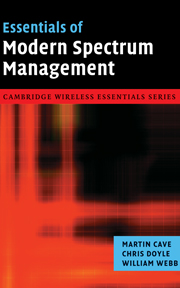Book contents
- Frontmatter
- Contents
- Acknowledgements
- I Emerging problems with the current spectrum management approach
- II Markets
- 4 Market solutions
- 5 Auctions
- 6 Spectrum trading: secondary markets
- 7 Technical issues with property rights
- 8 Economic issues with property rights
- 9 Competition issues relating to spectrum
- 10 Band management
- III Regulation
- IV Conclusions
- Further reading
- Abbreviations
- Author biographies
- Subject index
- References
7 - Technical issues with property rights
Published online by Cambridge University Press: 13 August 2009
- Frontmatter
- Contents
- Acknowledgements
- I Emerging problems with the current spectrum management approach
- II Markets
- 4 Market solutions
- 5 Auctions
- 6 Spectrum trading: secondary markets
- 7 Technical issues with property rights
- 8 Economic issues with property rights
- 9 Competition issues relating to spectrum
- 10 Band management
- III Regulation
- IV Conclusions
- Further reading
- Abbreviations
- Author biographies
- Subject index
- References
Summary
Introduction
As discussed in the introductory chapter, the key reason for managing spectrum is to avoid interference between different users. To do this, users are given licences which set out in some form their “rights” to transmit or receive. These licences can be stated in many different forms, for example:
through a particular technology (e.g. GSM),
through a particular use (e.g. mobile),
through a particular set of emission characteristics known as a mask (e.g. 50 dBm in band falling by 10 dB/MHz out of band).
In existing command-and-control methods user licences are typically specified in terms of the equipment or technology they are able to use, which by careful control of neighbouring uses avoids interference. However, this approach generally does not provide users with the flexibility to subsequently change their usage as circumstances change. For example, if a licence is stated in terms of a technology such as GSM this does not allow a licence holder to subsequently upgrade their network to 3G.
As has been discussed in Chapters 4 and 6, the use of market forces could significantly enhance the value derived from radio spectrum, and one of the key ways to enable these forces is through a trading regime that also allows change of use. Achieving this requires the users' rights, often termed “property rights” by analogy with land, to be defined in a different manner.
- Type
- Chapter
- Information
- Essentials of Modern Spectrum Management , pp. 105 - 122Publisher: Cambridge University PressPrint publication year: 2007

